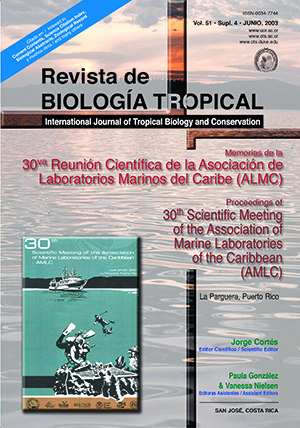Abstract
In July 1997, conspicuous white patches of necrotic tissue and bare skeleton began to appear on scleractinian corals in several bays around St. John, US Virgin Islands. Analysis of diseased coral tissue from five different species confirmed the presence of a Sphingomonas-like bacterium, the pathogen for plague type II. To date, 14 species of hard corals have been affected by plague type II around St. John. This disease was monitored at Haulover and Tektite Reefs at depths of 7-12 meters. The study site at Tektite Reef has >50% cover by scleractinian corals with 90% of hard corals being composed of Montastraea annularis. Monthly surveys at Tektite Reef from December 1997 to May 2001 documented new incidence of disease (bare white patches of skeleton) every month with associated loss of living coral and 90.5% of all disease patches occurred on M. annularis. The frequency of disease within transects ranged from 3 to 58%, and the area of disease patches ranged from 0.25 to 9000 cm2. The average percent cover by the disease within 1 m2 ranged from 0.01% (± 0.04 SD) to 1.74% (± 9.08 SD). Photo-monitoring of 28 diseased corals of 9 species begun in September 1997 at Haulover Reef revealed no recovery of diseased portions with all necrotic tissue being overgrown rapidly by turf algae, usually within less than one month. Most coral colonies suffered partial mortality. Very limited recruitment (e.g., of Agaricia spp., Favia spp. and sponges) has been noted on the diseased areas. This coral disease has the potential to cause more loss of live coral on St. John reefs than any other stress to date because it targets the dominant reef building species, M. annularis.References
Aronson, R. B. & W. Precht. 1997. Stasis, biological disturbance, and community structure of a Holocene coral reef. Paleobiol. 23: 326-346.
Boger, J.L. 2001. Patterns of scleractinian coral disease infections in Dominica, West Indies. Abstract, 30th Scientific Meeting of the Association of Marine Laboratories of the Caribbean. La Parguera, Puerto Rico. 16 p.
Bruckner, A.W. & R.J. Buckner. 1997. Outbreak of coral disease in Puerto Rico. Coral Reefs 16: 260. Bruckner, A.W. & E.P. Green. 2001. The Global Coral Disease Database. Abstract, 30th Scientific Meeting of the Association of Marine Laboratories of the Caribbean. La Parguera, Puerto Rico. 16 p.
Campbell, R.C. 1994. Statistics for Biologist. Cambridge University, New York. 446 p.
Croquer, A., S.M. Pauls & A.L. Zubillaga. 2001. Coral disease outbreak in a coral reef at Los Roques national Park, Venezuela. Abstract, 30th Scientific Meeting of the Association of Marine Laboratories of the Caribbean. La Parguera, Puerto Rico. 17 p.
Dustan, P. 1977. Vitality of reef coral populations off Key Largo, Florida: Recruitment and mortality. Environm. Geol. 2: 21-58.
Gladfelter, E. H., R.K. Monahan & W.B. Gladfelter. 1978. Growth rates of five reef-building corals in the northeastern Caribbean. Bul. Mar. Sci. 28: 728-734.
Gladfelter, W.B. 1982. White-band disease in Acropora palamata: Implications for the structure and growth of shallow reefs. Bul. Mar. Sci. 32: 639-643.
Harvell, C.D., K. Kim, J.M. Burkholder, R.R. Colwell, P.R. Epstein, D. J. Grimes, E.E. Hofmann, E.K. Lipp, A.D.M.E. Osterhaus, R.M. Overstreet, J.W. Porter, G.W. Smith & G.R. Vasta. 1999. Emerging marine diseases-climate links and anthroprogenic factors. Science 285: 1505-1510.
Hayes, R.L. and N.I. Goreau. 1998. The significance of emerging disease in the tropical coral reef ecosystem. Rev. Biol. Trop. 46 (Supl. 5): 173-185.
Jaap, W.C., J.W. Porter, J. Wheaton, K.Hacket, M. Lybolt, M. Callahan, C. Tsokos, G. Yanev & P. Dustan. 2000. Coral reef monitoring project executive summary. EPA Science Advisory Panel. 16 p.
Peters, E.C. 1996. Diseases of coral-reef organisms, p. 114-139. In C. Birkeland (ed.). Life and Death of Coral Reefs, Chapman Hall, New York.
Richardson, L.L. 1998. Coral diseases: what is really known? Trends Ecol. and Evol. 13: 438-443. Richardson, L.L., W.M. Goldberg, R.G. Carlton & J.C. Halas. 1998a. Coral disease outbreak in the Florida Keys: Plague Type II. Rev. Biol. Trop. 46 (Supl. 5): 187-198.
Richardson, L.L., W.M. Goldberg, K.G. Kuta, R.B. Aronson, G.W. Smith, K.B. Ritchie, J.C. Halas, J.S. Feingold & S. Miller. 1998b. Florida’s mystery coral killer identified. Nature 392: 557-558.
Rogers, C. & J. Beets. (in press). Degradation of marine ecosystems and decline of fishery resources in Marine Protected Areas in the US Virgin Islands. Environm. Conserv.
Santavy, D.L. & E.C. Peters. 1997. Microbial pests: coral disease in the western Atlantic. Proc. 8th Int. Coral Reef Symp. Panamá 1: 607-612.
Santavy, D.L., E. Mueller, J.M. Hawkridge, L. MacLaughlin, J.W. Porter & E.C. Peters. 2001. The prevalence of ten coral diseases in the Florida Keys and Dry Tortugas. Abstract, 30th Scientific Meeting of the Association of Marine Laboratories of the Caribbean. La Parguera, Puerto Rico. 17 p.
Szmant-Froelich, A. 1985. The effect of colony size on the reproductive ability of the Caribbean coral Montastrea annularis (Ellis and Solander). Proc. 5th Int. Coral. Reef Symp. 4: 295-300.
Weil, E., I. Urreizieta, J. Garzon-Ferreira, P. Gayle, D.L. Gil-Aguedelo & S. Zea. 2000. Local and geographic variability in the incidence of diseases in western Atlantic coral reefs. Abstract, 9th Int. Coral Reef Symp. Bali. 286 p.
Zar, J.H. 1984. Biostatistical Analysis. Prentice Hall, New Jersey. 718 p.
Comments

This work is licensed under a Creative Commons Attribution 4.0 International License.
Copyright (c) 2003 Revista de Biología Tropical


